Location: Ice Station Belgica
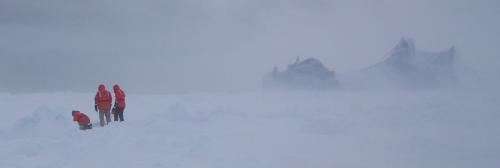 Erik, Chris, and Jeremy check to see if what lies ahead is safe for travel.
Erik, Chris, and Jeremy check to see if what lies ahead is safe for travel.
Yesterday I reported that our destination today was an area that had been dubbed the "zone of death” by those who scouted the location previously. Why would it be given such a terrible name? The thicker the snow and ice, the harder it is to survey and sample. We were told that the snow was deeper than any we’d seen yet, and that the area was full of ice blocks and very thick, very old ice. With a bit of worry we loaded the snowmobiles with our gear this morning and off we went into uncharted territories. Did this part of the ice floe live up to its reputation? Were there untold horrors awaiting us when we arrived? In a word, no! It turns out that the "zone of death” did not have the snow and ice thicknesses we thought. We spent the morning laying a short transect line and discovered that the snow and ice layers were actually thinner than at the site we’d been working near the ship. It just goes to show that first impressions aren’t always accurate.
Part of our team went back out this afternoon to finish data collection in the "zone that wasn’t so bad,” and some of us stayed on the ship to help edit bathymetry files for the information technology (IT) staff on board. The ship collects a great deal of data in transit – seawater temperature and salinity, meteorological conditions, etc. One of the most interesting things to me is the bathymetry that is done on the ship. Bathymetry means "depth measuring” and it’s a relatively simple process. In the early days of bathymetry simple soundings were made to measure depths. A weighted rope was tossed over the side of the ship and allowed to drop to the ocean bottom. The length of the rope extending into the water was measured and recorded as the depth of the water at that point.
Today bathymetry is done using sonar. Sonar uses sound to create two and three dimensional pictures of the ocean bottom. The principle is simple – sound waves are emitted from a device in the hull of the ship then bounce back toward the source when they hit a hard surface. Since the ocean bottom is the hardest surface around they reflect off the ocean bottom back to the ship. The device times how long it takes for the reflected wave (the echo) to reach the ship. If you know how fast something is going and how long it takes to get to its destination you can calculate how far away the object is. Sound travels through seawater at a constant rate, so knowing that value and the time it takes the echo to reach the ship allows you to calculate the distance from the ship to the ocean bottom. Onboard computers automate this process, so at any time you can look at a monitor and see what the depth is at the current location. The ocean bottom today is 4058 meters below the ship.
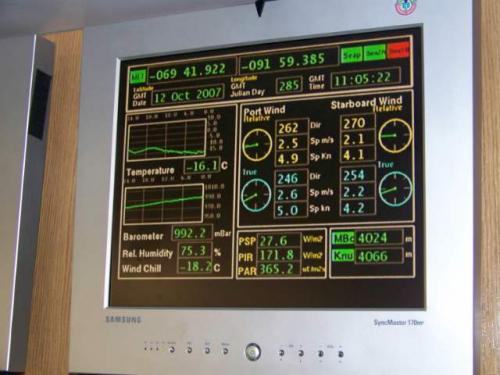 Monitors and televisions aboard the ship display current weather conditions,
the ship’s position, sea floor depth, and other continuously collected data.
Monitors and televisions aboard the ship display current weather conditions,
the ship’s position, sea floor depth, and other continuously collected data.
A computer takes the sonar data and turns it into maps. Bathymetric maps show the depths and contours of the ocean floor like topographic maps show the elevations and contours of land masses. The Palmer has two systems for bathymetry – a single channel and a multi-channel system. The single channel system sends out a single sound pulse every few seconds and creates a simple x vs. y (time vs. depth) graph of the data. The multi-channel system sends out 191 pulses at a time over a wide area, creating a three-dimensional picture of the ocean floor. Scientists use this data to help understand the geology of the ocean floor.
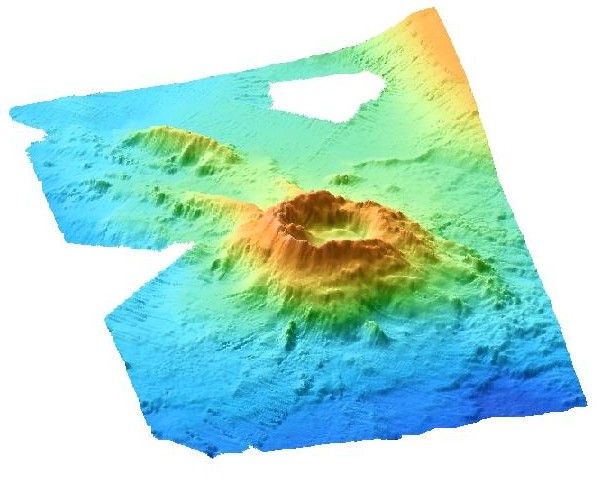
The image above is a bathymetric map of an underwater volcano produced on an earlier cruise. The volcano is located near the Antarctic Peninsula. The computer adds shading to help visualize the underwater features - dark blue is the deepest part of the ocean, the brown color is the shallowest.
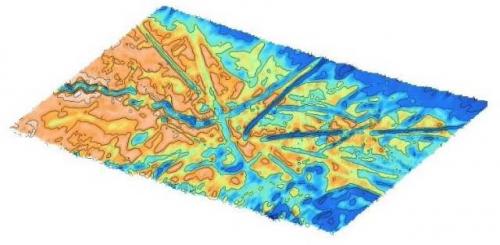
This map was produced on this cruise at a depth of around 400 meters. Again, the darker the color, the deeper the water. The long lines you see are gouges in the ocean floor carved out by icebergs. These seafloor features are called iceberg scours.
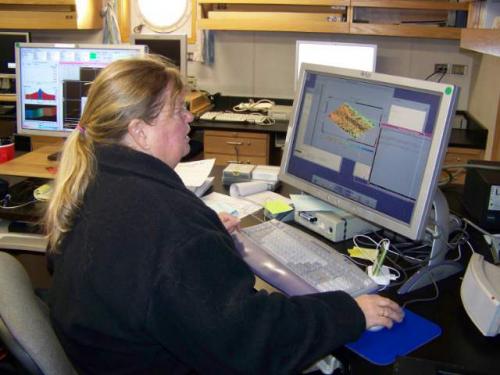 Kathleen prepares a bathymetric map from data collected on the cruise.
Kathleen prepares a bathymetric map from data collected on the cruise.
Kathleen is responsible for overseeing many of the data systems on board. She told me she was a geophysicist who ran away to sea! She’s been working on scientific cruises for ten years.
Try This: Here are some things to think about or research that relate to sonar. • Find out what other tools use sound waves to help visualize or locate objects. • Sonar is an acronym; what words is sonar formed from? • Sound travels at different rates through different materials. How does the speed of sound in air compare to the speed of sound in water? • Why is the speed of sound in seawater different from fresh water?
Marine mammals and seabirds spotted by Brent today: Minke whale Crabeater seal (We’re still watching a pair of these hauled out on the ice by the ship - no pups yet.) Snow petrel Antarctic petrel Adelie penguin Emperor penguin
That’s all for now from Ice Station Belgica. Tomorrow we’re headed back to our first work site to check the ice thickness the old-fashioned way - by digging out the snow and drilling holes in the ice every five meters. It’s a 300 meter line, so I’d better get my rest!

